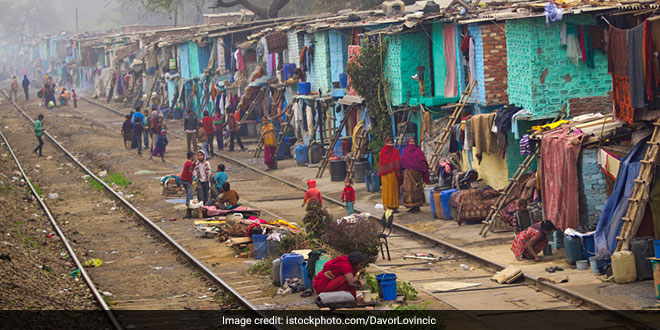Highlights
- Jangpura, is barely 6 kms away from the seat of central governance
- Slum dwellers of Jangpura defecate on railways tracks of Hazrat Nizamuddin
- Public toilet in Jangpura does not have water connection
New Delhi: Pushpa Devi, 40, takes a walk along the railway tracks every morning to relieve herself, sitting and hiding under the bushes in Jangpura, a mixed neighbourhood that is part of the South Delhi Municipal Corporation (SDMC)-governed area declared open-defecation free (ODF) last year under the much-hyped Swachh Bharat Mission.
The area is barely six kilometres away from the seat of central governance, Raisina Hill, which houses the Rashtrapati Bhavan, almost all central government offices, including the PMO and the Parliament House.
Pushpa is not the only one to defecate openly in Jangpura and surrounding areas, including parts of Nizamuddin West located on the railway tracks leading to one of the busiest railway stations in the city, Hazrat Nizamuddin.
Also Read: High Amounts Of Heavy Metals In Ground Water In Delhi’s Krishna Vihar, Says Research
The area stinks, more so in the mornings, as bushy areas on either side of the railway tracks remain strewn with faeces, belying the claims of the SDMC that announced on October 2 last year that all the wards under its jurisdiction have become Open Defecation Free.
The south civic body said on Mahatma Gandhi’s birthday, which is also celebrated as Swachh Bharat Diwas, that it had followed the protocol and norms of construction of toilets under Prime Minister Narendra Modi’s Swachh Bharat Mission and provided one toilet within 500 metres in every area of its jurisdiction.
True. A community toilet has also been constructed in the Jangpura area that is home to some 300 slum dwellers. The public toilet is in a bad shape. It stinks nauseatingly. There are cobwebs on its dusty walls and corners as if it had not been used for a long time. There were broken buckets lying around and there was no water.
SDMC spokesperson Radha Krishna blamed people for not using the community toilet. He said the civic body had constructed toilets for individual families which applied for the scheme. “It is the duty of a village councillor to inform us regarding the construction of the toilets,” Ms Krishna told IANS.
Sukhvati Kaur, a labourer, said the residents, particularly women, understood the importance of health and hygiene. But, she pointed out, “is this public toilet maintained so well that we won’t catch diseases there?”
Why do we have to go that far? Look at the toilet. It is not even maintained well, nobody has cleaned it for months. The toilet stench is horrible, Sukhvati, who appeared in her 40s, told IANS.
Sukhvati said she and others in the neighbourhood realised how dangerous it is to walk on the railway tracks, particularly when it is dark.
“Trains have hit a few people while crossing the tracks,” she said, adding women usually come out in groups before first light.
Sheela Kumari, 80, said not a single person in the area had received money to construct toilets. “Unless we receive funds, how can we construct a toilet? I have not received my first old-age pension till now. I don’t expect to receive money for toilet construction which is actually more than my pension.”
Pushpa Devi, in her late 40s, said at least they had bushes to hide under while defecating “but bathing is a big problem”. She said women in the area take water in buckets and bathe in the open.
Many women IANS spoke with in the area said they would finish bathing before dawn. And if they fail to do so, they either skip their bath or bathe in the open area with their clothes on.
The area, according to a Delhi government physician, is more prone to diseases, especially among women, than any other locality in south Delhi. “Human waste contains millions of viruses which terribly affect vulnerable women during menstruation or during their pregnancy,” said G.P. Kaushal, who works at Aruna Asif Ali Hospital.
And what happens in south Delhi is in many ways illustrative of the rest of the country as well. Most of such policies and programmes of the government remain mostly on paper with poor executive machinery at the municipal level and little or no supervision and audit of their performance and feedback from the people who are supposed to be its beneficiaries.






























